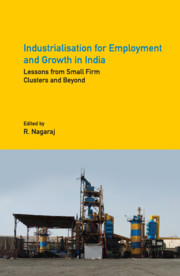Book contents
- Frontmatter
- Contents
- List of Tables
- List of Figures and Maps
- Preface and Acknowledgements
- 1 Introduction
- 2 Garment Cluster in Kolkata: The Untold Story of Expansion Relying on Low-end Domestic Demand
- 3 Constraints to Upgrading and Employment Expansion in the Tiruppur Knitwear Cluster
- 4 Determinants of Employment in the Indian Automobile Industry
- 5 Upgrading Technology and Space as Collective Strategy: Creation of Jobs and Market Potential in Gujarat’s Ceramic Clusters
- 6 Sports Equipment Manufacturing in India: A Firm-level Inquiry into Growth and Employment Dynamism
- 7 Aligarh Lock Cluster: Unravelling the Major Impediments
- 8 Continued Misery or a Change in Fortune? The Case of the Howrah Foundry Industry
- 9 Redevelop and Perish, or Survive and Grow? The Case for Supporting Informal Leather Enterprises in Dharavi, Mumbai
- 10 Growth Performance, Competitiveness and Employment in MSMEs: A Case Study of the Rajkot Engineering Cluster
- 11 Manufacturing and Automation
- About the Contributors
- Index
7 - Aligarh Lock Cluster: Unravelling the Major Impediments
Published online by Cambridge University Press: 31 July 2021
- Frontmatter
- Contents
- List of Tables
- List of Figures and Maps
- Preface and Acknowledgements
- 1 Introduction
- 2 Garment Cluster in Kolkata: The Untold Story of Expansion Relying on Low-end Domestic Demand
- 3 Constraints to Upgrading and Employment Expansion in the Tiruppur Knitwear Cluster
- 4 Determinants of Employment in the Indian Automobile Industry
- 5 Upgrading Technology and Space as Collective Strategy: Creation of Jobs and Market Potential in Gujarat’s Ceramic Clusters
- 6 Sports Equipment Manufacturing in India: A Firm-level Inquiry into Growth and Employment Dynamism
- 7 Aligarh Lock Cluster: Unravelling the Major Impediments
- 8 Continued Misery or a Change in Fortune? The Case of the Howrah Foundry Industry
- 9 Redevelop and Perish, or Survive and Grow? The Case for Supporting Informal Leather Enterprises in Dharavi, Mumbai
- 10 Growth Performance, Competitiveness and Employment in MSMEs: A Case Study of the Rajkot Engineering Cluster
- 11 Manufacturing and Automation
- About the Contributors
- Index
Summary
Introduction
One of the bright-dark characteristics of the Indian economy has been the remarkable growth rates of output with a low level of employment elasticity; as a result, the Indian economy slipped into the course of jobless growth. For researchers and policymakers, this jobless growth has been the main motivation behind shifting the attention from large to small enterprises. The importance of small and medium enterprises (SMEs) is quite discernible in the policy documents because of their significant employment-generating potential (Das 2008). Not merely the employment-generating capacity but also the ability to produce custom-made goods to satisfy the ever-changing demands of the consumer makes this sector even more significant from the industrialisation perspective. Hence, SMEs are supposed to have the dual potential of absorbing significant workforce by using labour-intensive technologies and handling the ever-rising international competition through adaptive skills.
Along with adaptability and flexibilities, SMEs mainly draw benefits from the concentration of horizontally and vertically related firms at a particular location. This characteristic of SMEs was first explained by Marshall (1920) who denoted this as an industrial district. Later, various new terms were coined, such as innovative milieu, learning region and cluster, where significant literature focuses on the idea of the cluster. The existing literature on cluster emphasises that the growth and competitiveness of small firms in developed as well as developing countries have been sourced from cooperative learning and innovation. Porter (1990) analyses that the competitive advantage of a nation is derived from the local characteristics of its industrial cluster. Similarly, Schmitz and Nadvi (1999) study the industrial clusters located in developing countries and explain that firms draw their competitive capabilities mainly from the externalities arising out of the proximity of firms in a certain geography.
The success stories of clusters in European countries, particularly of Italy, and of developing countries such as India set up the examples that SMEs cater to the needs of not only the local market but also the international market. Many Indian clusters, such as the knitwear cluster of Tirupur, the ceramic cluster of Morbi, the leather cluster of Kanpur, the brass cluster of Moradabad and the garment cluster of the National Capital Region (NCR), and others, have emerged to be successful exporters in the international market over a period of time.
- Type
- Chapter
- Information
- Industrialisation for Employment and Growth in IndiaLessons from Small Firm Clusters and Beyond, pp. 153 - 172Publisher: Cambridge University PressPrint publication year: 2021



